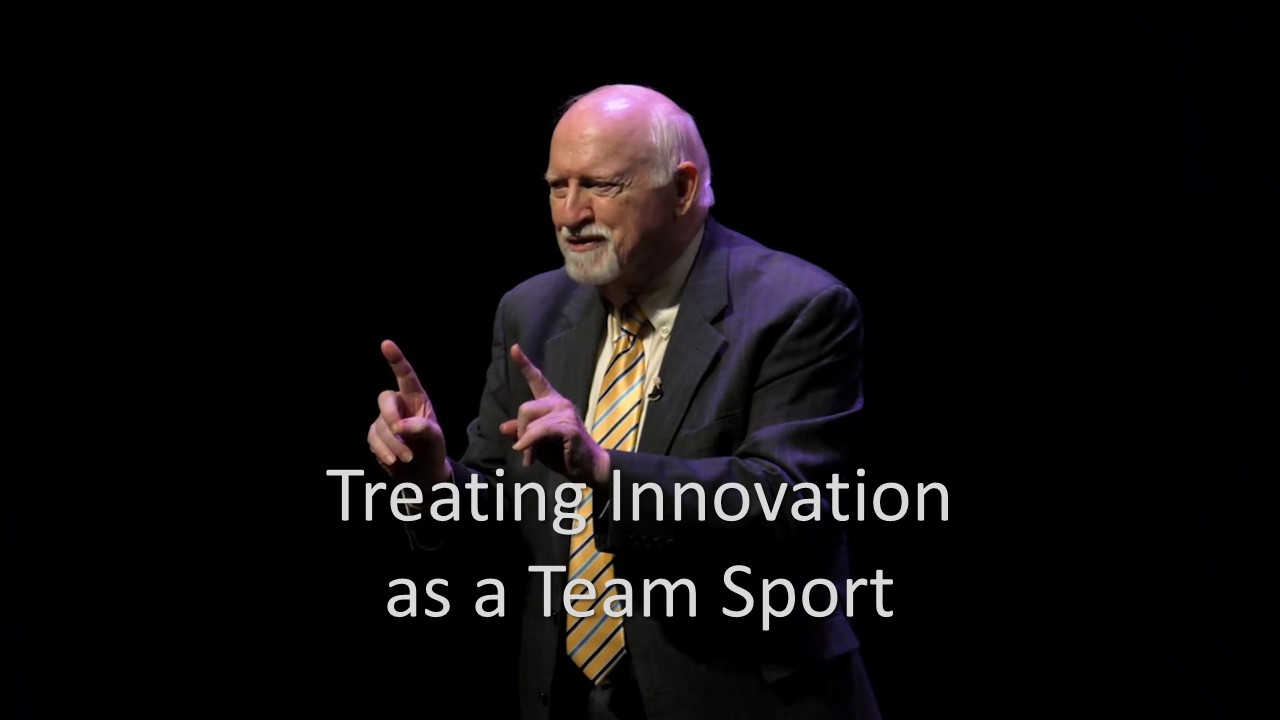Short Clips from Keynote Openings
For nearly 20 years, "Leadership FIRST" has been among my most frequently-requested presentations. This clip illustrates how I use the introduction to pre-frame the heart of the message.
A Bit Dated, But It's Still
My Favorite Intro of All Time
After decades of speaking around the world, the opening of one keynote still stands out as my absolute favorite. Here's a five-minute clip that encapusulates it. But first you should know the backstory.
This was a keynote on cultural change presented to the entire corporate leadership at Idearc Media. They had met to realign strategically due to growing obsolescence for their flagship product, the Yellow Pages book.
This intro was literally impromptu. The idea for it popped into mind just 60 seconds before I stepped on stage. The "man in the pink shirt" had no idea what I was about to do. Only the woman who handed him the microphone was in the "know."
The scene could not have played out better had we rehearsed it repeatedly.
An Ever-Popular Opening Story
And speaking of "favorites," here's a short clip which centers on a story that my audiences always enjoy as an opener. I like it in large part because the central character happens to be one of my heroes.
Some of My Signature Keynote Presentations
(Tap or click on speech titles for expanded descriptions.)
► Agility, Speed, Innovation
The three king-makers in today's business world
The dividing line between success and failure in today's hyper-competitive marketplace is often the ability of a corporate culture to embrace agility, speed, and innovation:
- the agility to turn on a dime without losing momentum
- the speed to deliver faster than the competition without losing quality or customer care
- the innovation to overcome any obstacle which looms as a threat
Agility, speed, and innovation have thus become the king-makers for modern businesses. Failure to pay them homage can be fatal.
This keynote presentation offers proven, practical insights into building a culture which pays these king-makers their due respect.
► Trust-Centered Leadership: Unleashing Peak Performance
How leaders build trust to bring out the very best in their people
All of us reach our fullest potential and maintain our highest motivation in settings of high trust. Trust frees us from fears, anxiety, misgivings, and guarded communication that otherwise thwart performance. This presentation provides solid "know-how" for creating a high-trust culture. It also explores the vital link between organizational performance and trust.
This keynote draws on seminal concepts and principles from my best-selling book Leadership and the Power of Trust.
► Whatever Happened to Accountability?
What's behind our accountability crisis — and what we can do about it
There's general consensus that accountability is in short supply. However, many explanations offered for this development are somewhat superficial, if not simplistic.
I use this keynote to probe historical, cultural, social, and even spiritual influences which have dimished accountability in American life. Then I highlight practical steps which we can undertake individually and collectively to reverse this worrisome trend.
► Leadership FIRST
Five qualities which distinguish great leaders
Most of us immediately recognize the difference between reporting to a good manager and reporting to a genuine leader. In this presentation I highlight the distinction between good management and solid leadership.
I look at five vital qualities which true leadership brings to the table, using a simple acronymn (the word "FIRST") to help the audience remember them. The presentation examines each of the five qualities and uses unforgettable examples to show how they reinforce one another.
► When to Lead, When to Manage
Wearing the right hat at the right time — and knowing the difference between them
People commonly use the words "leadership" and "management" interhangeably, as though they are one and the same. But most of us instinctively recognize the difference between reporting to a good manager — perhaps an exceptional one — and reporting to a genuine leader.
In this presentation I delve into the distinctives between leadership and management. I show how they should work in tandem, like the two pedals of a bicycle. And I describe the kinds of situations which call for the leadership pedal to carry the load and the ones which call for the management pedal to do so.
I then explore the contrast in outlooks, priorities, and focus which set leadership and management apart.
► Change Management
Five things You MUST get right!
In today's topsy-turvy marketplaces, transformational change is often the only choice for survival. The change process itself, however, puts added strain on organizations. And with that strain come increased demands on leadership. Unfortunately, the entire process easily goes awry because leaders overlook pivotal considerations for managing change.
I know the challenges of change management well. For decades people have looked to me as a "go-to" person for organizations wanting to turn around or get back on track. In this presentation I lay out five of the most important lessons I've learned for effecting lasting, dynamic change. And I tie each lesson to unforgettable examples and illustrations.
In particular I address the following dynamic of change management.
- Because change raises uncertainty and anxiety, I show how to keep anxiety in check.
- Because clarity is essential to overcoming uncertainty, I highlight five arenas of essential clarity.
- Because the workforce must be inspired to embrace the change, I lay out ways to create inspiration.
► Seven Hallmarks of Highly-Trusted Leaders
Leadership character and behaviors that Inspire trust
Even in organizations where trust is otherwise low, it's common to find a particular leader who is widely and thoroughly trusted.
What's the difference that leads to some leaders being trusted, others distrusted? In my book Leadership and the Power of Trust, I identify seven qualities of highly-trusted leaders. In this keynote presentation, I visit these seven qualities and explore them at greater depth.




